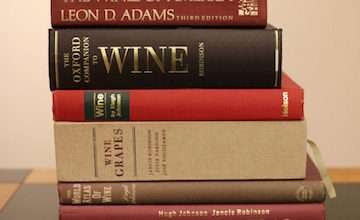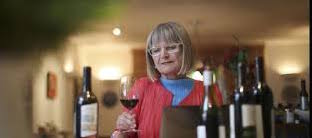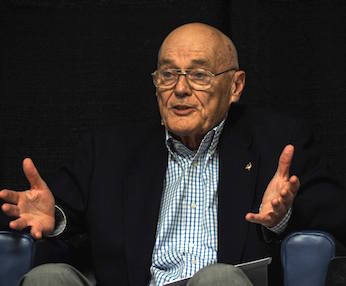Wine Journalists Get Their Due
At a wine tasting many years ago, a man walked up to wine journalist Bob Thompson and stuck a glass in his face and exclaimed, “Do you like this?” Thompson, the wine columnist for the Hearst San Francisco Examiner at the time, went to the paper’s editor the next morning, and quit. The man with the glass, Thompson said, “Wanted me to tell him if he liked the wine. I wanted to be the guy who showed him what he thought he’d like. I did not like the idea of being the guru. It’s not who I wanted to be.”
The now retired Thompson, 84, wrote about wine for 37 years. “What I thought I was doing  most of the time was telling people how to make up their own minds (about wine). A.J. Liebling once said good journalism is based on good reporting. Alright, here it is, you figure out whether you like the wine or not; and here are the tools that will help you.”
most of the time was telling people how to make up their own minds (about wine). A.J. Liebling once said good journalism is based on good reporting. Alright, here it is, you figure out whether you like the wine or not; and here are the tools that will help you.”
Thompson’s body of work, along with several other wine writers, authors, and historians, reside in the wine writer’s collection of the University of California Davis wine library. It is the largest such collection in the country; and it is about to expand.
The Davis wine collection holds more than 30,000 books and rare manuscripts, maps and imprints on wine dating to 1287, including the wine writer collection.
In addition to Thompson, the works of British wine writers Jancis Robinson and Hugh Johnson, have been curated; as well as the collections of the late writer Roy Brady and early American wine writer Leon Adams.
 Robinson, 68, a wine columnist for The Financial Times, is also the author of The Oxford Companion to Wine; The World Atlas of Wine, co-authored with Hugh Johnson; American Wine and Vines, Grapes & Wines. “I have had a particularly long run as a journalist,” Robinson wrote to me, “and I’m still going strong. That period has coincided with the most extraordinary flowering of consumer interest in wine and expansion and evolution of the wine world.
Robinson, 68, a wine columnist for The Financial Times, is also the author of The Oxford Companion to Wine; The World Atlas of Wine, co-authored with Hugh Johnson; American Wine and Vines, Grapes & Wines. “I have had a particularly long run as a journalist,” Robinson wrote to me, “and I’m still going strong. That period has coincided with the most extraordinary flowering of consumer interest in wine and expansion and evolution of the wine world.
The books of Hugh Johnson, 79, include The Story of Wine, the aforementioned The World Atlas of Wine, and the Modern Encyclopedia of Wine. “My aim then, and still today, was to bring wine, and the understanding of wine, to as wide an audience as possible,” Johnson wrote me in an email.
Axel Borg, Davis’ wine and food science bibliographer, explained to me the reasoning behind  developing a wine writers collection: “It’s to understand how wine writers communicated. They are the movers and shakers (of wine) … They are lens onto how wine becomes viewed.”
developing a wine writers collection: “It’s to understand how wine writers communicated. They are the movers and shakers (of wine) … They are lens onto how wine becomes viewed.”
Kevin Miller, head of special collections at Davis, sees wine journalists as “connectors to wine science, commerce, and agriculture.” The university, which is about to hire a curator for the collection according to Miller, will be taking “a holistic approach” as it brings in more writers; which will include for the first time, the burgeoning niche of bloggers.
Wine journalism, Miller explained, “Exposes the wine writers’ process; and is a longitudinal study of how tastes have changed. … How do we understand the craft of journalism within the niche of wine?”
Added Jessica Nusbaum, director of communications for UC Davis’ library, “Wine writers and journalists belong alongside the giants of the wine industry; they belong in that constellation.”
Warren Winiarski, the founder of Stag’s Leap Wine Cellars, has always been cooperative and convivial in his dealings with wine journalists, including this reporter. Winiarski has become a benefactor of the wine writer’s collection.
I visited the archives recently and it reveals personal letters, tasting notes, and articles written and published in newspapers, magazines and books.
For instance, Johnson’s lede in the defunct magazine Cuisine, in November 1983, reads: “The person who comes up with another name for sparkling wine as evocative and snappy as Champagne, without taking in vain the name of a French province and its produce, is my candidate for the next Nobel Peace Prize.”
 Or take Robinson’s 2004 honest take in “Great Grüners” about one of Austria’s signature white wines, Grüner Veltliner. “The famous 2002 Grüner Veltliner v. Chardonnay blind tasting included several Grüners that combined maturity with grace, but I was disappointed at how little a 2001 Schütt Smaragd, even from such an admirable producer as Emmerich Knoll, seemed to have left to give …”
Or take Robinson’s 2004 honest take in “Great Grüners” about one of Austria’s signature white wines, Grüner Veltliner. “The famous 2002 Grüner Veltliner v. Chardonnay blind tasting included several Grüners that combined maturity with grace, but I was disappointed at how little a 2001 Schütt Smaragd, even from such an admirable producer as Emmerich Knoll, seemed to have left to give …”
It is worthwhile to read Bob Thompson’s straight-ahead American writing in the then Hearst San Francisco Examiner — in one of his last columns, of 503 total tomes — titled “The World’s Awash in Chardonnay.”
“People who like to ding the United States like to complain about being Coca-Colonized. Well, who would like to take the blame for Chardonnay?” he began in May of 2000. “The stuff apparently grows faster and farther than kudzu, and it neither started nor stopped on our shores.
“At the recently concluded Mondiale de Bruxelles, Chardonnay from everywhere was everywhere. It could have started leaking out of the chandeliers without getting into any more glasses than it already had.”
Thompson spends much of his time these days writing for himself, on such disparate subjects as the function of the brain and players of the iconic Modern Jazz Quartet, for both of which he asks rhetorically, “Why can’t I be known for that?”
In his dry-humored and humble manner – but no less cutting – Thompson told me over lunch recently, “I didn’t want to be a mouthpiece. What I thought I was doing most of the time, was telling people how to make up their own minds. I don’t think I succeeded.”
Asked if his writing was cynical he answered, “Skeptical, maybe. I was in no way a rebel. I looked for mentors who had established themselves more or less at the top of the business.”
Thompson had written much about high-alcohol, fruit-forward wines that have been more the norm than the exception with industrially produced California wine. He was quick to add though, “I developed a palate that I didn’t foist on the public. But I lost the battle to the big wine guys.”
When he realized in 2005 that “I couldn’t talk these people (out of making more balanced wine), and do them any good, I quit.”
Thompson, however, is grateful that UC Davis has acknowledged his work. I’m pretty pleased that it’s there (the collection). I spent a lot of years and to have some of that recognized is a helluva lot better than getting a plague.”
So then, what place do wine writers have in our culture?
“Very small,” he said with a laugh.
Summing up wine writing’s role best is perhaps Thomas Pinney, an emeritus professor of English at Pomona College and the author of “A History of Wine in America”. Addressing Pomona alumni in 1998, he said, “Why should wine, alone among the important items of food and drink, have inspired this kind of writing?
“No one has ever devoted a book to the pleasures of water-drinking; we have no lists of the great vintages in cranberry juice; no one argues about the sources of the most delicate or most flavorful soft drinks. The ‘Magic of Milk’ is not a title to be taken very seriously. No doubt there are many varieties of cabbage around the world, but who apart from a specialist, wants to read about them?”
___________________________________________________________
Alan Goldfarb has been writing about wine for nearly 30 years. His most recent work: A couple of articles involving Rupert Murdoch were published in THE WINE SPECTATOR; an interview with Francis Coppola and Inglenook will soon appear in the ALTA JOURNAL OF CALIFORNIA; a profile of Stu & Charlie Smith of Smith-Madrone, will soon be published in SEVEN-FIFTY DAILY; and two pieces on a Sonoma Coast restaurant and wine, is to be featured in THE ART OF EATING MAGAZINE.


Thank you for publishing this article. I knew Bob a little bit when I was at Ridge Vineyards in the early 70’s. It was a book titled “The Fine Wines of California” written by Bob Blumberg and Hurst Hannum that first got me interested in wine fresh out of Cal. I used it as a guide book that took me first to Mirrasou and then up to Ridge in February of 1972. In those early days even before the Wine Spectator started in San Diego, it was wine writers such as Bob and Hurst. Then Jack Shelton started a restaurant guide in San Francisco and torched Ernie’s and and I think Le Trianon. It was taken over by the late Bob Finigan (sp) who then started a wine guide. In Southern California there was Robert Lawrence Balzer and Nate Chroman, both deceased, who while having somewhat sordid reputations were great promoters of California wine. There was Charlie Olken and Earl Singer and others. The nascant wineries; Ridge, Mayacamus, Freemark Abby, Chateau Montelena then Caymus and both Stags Leaps, were desperate for publicity as there was no way to tell our story. There were tasting groups, one that was founded by I think Joel Peterson’s father and mother, then the Vintners Club founded by Jerry Draper. The results from these various tasting became an almost underground news feed for how wine fared. Forgive me as I have gone off topic, misspelled names and omitted worthy people
Yes, I remember Robert Finigan’s Private Guide to Wine and have several of Robert Balzer’s books (and took several of his classes on the Queen Mary… but that’s another story!!). I have a large collection of wine books and would like to submit a list to the UC Davis collection. How do I get in touch with them? I just donated my collection of Robert Parker’s Wine Advocate – issues 30-something up to current – to another wine library in McMinnville Oregon but would chauvinistically prefer to leave the rest of my collection to a California school!!
Contact one of the three folks I cited in my article, the ones affiliated with Davis’ wine writer collection.
George:
Contact Jane Fortner at: [email protected]. Tell where you heard about it.
Nary a mention of the formidable, Jerry D. Mead’s Mead on Wine.?